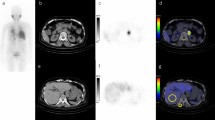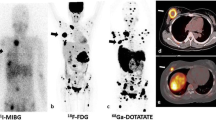Abstract
Background
The enhancement of metaiodobenzylguanidine single photon emission computed tomography (MIBG SPECT) imaging through the addition of CT images fused with SPECT data (coregistered MIBG SPECT/CT imaging) is new technology that allows direct correlation of anatomical and functional information. We hypothesized that MIBG SPECT/CT imaging would provide additional information and improve diagnostic confidence for the radiological localization of a pheochromocytoma, in particular for patients at high risk of multifocal or recurrent disease.
Methods
A retrospective study of all patients investigated by MIBG SPECT/CT at our institution from 2006 to 2008 for a suspected pheochromocytoma was performed. Each case was compared with conventional radiological investigations to determine whether MIBG SPECT/CT was able to improve diagnostic confidence and provide additional diagnostic information compared with conventional imaging alone.
Results
Twenty-two patients had MIBG SPECT/CT imaging for a suspected pheochromocytoma. Fourteen patients had positive MIBG SPECT/CT imaging results correlating with imaging by CT or magnetic resonance imaging in all cases. In six cases, MIBG SPECT/CT provided additional information that altered the original radiological diagnosis. Five patients with a pheochromocytoma-associated germline mutation had multifocal disease excluded by MIBG SPECT/CT. Patients without a germline mutation that had positive biochemistry and a solitary lesion with conventional imaging had no diagnostic improvement with MIBG SPECT/CT imaging.
Conclusions
MIBG SPECT/CT fusion imaging is a sensitive and specific radiological imaging tool for patients suspected to have pheochromocytoma. The particular strengths of MIBG SPECT/CT are detection of local recurrence, small extra-adrenal pheochromocytomas, multifocal tumors, or the presence of metastatic disease.


Similar content being viewed by others
References
Whalen RK, Althausen AF, Daniels GH. Extra-adrenal pheochromocytoma. J Urol. 1992;147:1–10.
Neumann HP, Bausch B, McWhinney SR, et al. Germ-line mutations in nonsyndromic pheochromocytoma. N Engl J Med. 2002;346:1459–66.
Amar L, Servais A, Gimenez-Roqueplo AP, et al. Year of diagnosis, features at presentation, and risk of recurrence in patients with pheochromocytoma or secreting paraganglioma. J Clin Endocrinol Metab. 2005;90:2110–6.
Walther MM, Keiser HR, Linehan WM. Pheochromocytoma: evaluation, diagnosis, and treatment. World J Urol. 1999;17:35–9.
Lenders JW, Eisenhofer G, Mannelli M, Pacak K. Pheochromocytoma. Lancet. 2005;366:665–75.
Timmers HJ, Kozupa A, Eisenhofer G, et al. Clinical presentations, biochemical phenotypes, and genotype-phenotype correlations in patients with succinate dehydrogenase subunit B-associated pheochromocytomas and paragangliomas. J Clin Endocrinol Metab. 2007;92:779–86.
Brouwers FM, Eisenhofer G, Tao JJ, et al. High frequency of SDHB germline mutations in patients with malignant catecholamine-producing paragangliomas: implications for genetic testing. J Clin Endocrinol Metab. 2006;91:4505–9.
Greenblatt DY, Shenker Y, Chen H. The utility of metaiodobenzylguanidine (MIBG) scintigraphy in patients with pheochromocytoma. Ann Surg Oncol. 2008;15:900–5.
Miskulin J, Shulkin BL, Doherty GM, et al. Is preoperative iodine 123 meta-iodobenzylguanidine scintigraphy routinely necessary before initial adrenalectomy for pheochromocytoma? Surgery. 2003;134:918–22; discussion 922–3.
Bhatia KS, Ismail MM, Sahdev A, et al. 123I-metaiodobenzylguanidine (MIBG) scintigraphy for the detection of adrenal and extra-adrenal pheochromocytomas: CT and MRI correlation. Clin Endocrinol (Oxf). 2008;69:181–8.
Mihai R, Gleeson F, Roskell D, et al. Routine preoperative (123)I-MIBG scintigraphy for patients with pheochromocytoma is not necessary. Langenbecks Arch Surg. 2008;393:725–7.
Wiseman GA, Pacak K, O’Dorisio MS, et al. Usefulness of 123I-MIBG scintigraphy in the evaluation of patients with known or suspected primary or metastatic pheochromocytoma or paraganglioma: results from a prospective multicenter trial. J Nucl Med. 2009;50:1448–54.
Rozovsky K, Koplewitz BZ, Krausz Y, et al. Added value of SPECT/CT for correlation of MIBG scintigraphy and diagnostic CT in neuroblastoma and pheochromocytoma. AJR Am J Roentgenol. 2008;190:1085–90.
Strobel K, Burger C, Schneider P, et al. MIBG-SPECT/CT-angiography with 3-D reconstruction of an extra-adrenal pheochromocytoma with dissection of an aortic aneurysm. Eur J Nucl Med Mol Imaging. 2007;34:150.
Maurea S, Cuocolo A, Reynolds JC, et al. Diagnostic imaging in patients with paragangliomas. Computed tomography, magnetic resonance and MIBG scintigraphy comparison. Q J Nucl Med. 1996;40:365–71.
Ilias I, Pacak K. Current approaches and recommended algorithm for the diagnostic localization of pheochromocytoma. J Clin Endocrinol Metab. 2004;89:479–91.
Bomanji J, Levison DA, Flatman WD, et al. Uptake of iodine-123 MIBG by pheochromocytomas, paragangliomas, and neuroblastomas: a histopathological comparison. J Nucl Med. 1987;28:973–8.
Wieland DM, Wu J, Brown LE, et al. Radiolabeled adrenergi neuron-blocking agents: adrenomedullary imaging with [131I]iodobenzylguanidine. J Nucl Med. 1980;21:349–53.
Hoefnagel CA, Voute PA, de Kraker J, Marcuse HR. Radionuclide diagnosis and therapy of neural crest tumors using iodine-131 metaiodobenzylguanidine. J Nucl Med. 1987;28:308–14.
Fischer M, Kamanabroo D, Sonderkamp H, Proske T. Scintigraphic imaging of carcinoid tumours with 131I-metaiodobenzylguanidine. Lancet. 1984;2:165.
Evans AE, D’Angio GJ, Knudson AG, Seeger RC (ed). Advances in neuroblastomas research. New York: Alan R. Liss; 1988.
Lumbroso JD, Guermazi F, Hartmann O, et al. Meta-iodobenzylguanidine (mIBG) scans in neuroblastoma: sensitivity and specificity, a review of 115 scans. Prog Clin Biol Res. 1988;271:689–705.
Roach PJ. Combining structure and function: the future of medical imaging. Int Med J. 2005:577–9.
Castaldi P, Rufini V, Treglia G, et al. Impact of 111In-DTPA-octreotide SPECT/CT fusion images in the management of neuroendocrine tumours. Radiol Med. 2008;113:1056–67.
Eisenhofer G, Siegert G, Kotzerke J, et al. Current progress and future challenges in the biochemical diagnosis and treatment of pheochromocytomas and paragangliomas. Horm Metab Res. 2008;40:329–37.
Hickman PE, Leong M, Chang J, et al. Plasma free metanephrines are superior to urine and plasma catecholamines and urine catecholamine metabolites for the investigation of pheochromocytoma. Pathology. 2009;41:173–7.
Yu R. Ordering pattern and performance of biochemical tests for diagnosing pheochromocytoma from 2000 to 2008. Endocr Pract. 2009:1–27.
Manger WM, Gifford RD (eds). Clinical and experimental pheochromocytoma. Cambridge: Blackwell Science; 1996.
Alderazi Y, Yeh MW, Robinson BG, et al. Pheochromocytoma: current concepts. Med J Aust. 2005;183:201–4.
Manger WM. An overview of pheochromocytoma: history, current concepts, vagaries, and diagnostic challenges. Ann N Y Acad Sci. 2006;1073:1–20.
Abe M, Orita Y, Nakashima Y, Nakamura M. Hypertensive crisis induced by metoclopramide in patient with pheochromocytoma. Angiology. 1984;35:122–8.
Lawrence AM. Glucagon provocative test for pheochromocytoma. Ann Intern Med. 1967;66:1091–6.
Eriksson B, Bergstrom M, Sundin A, et al. The role of PET in localization of neuroendocrine and adrenocortical tumors. Ann N Y Acad Sci. 2002;970:159–69.
Rufini V, Calcagni ML, Baum RP. Imaging of neuroendocrine tumors. Semin Nucl Med. 2006;36:228–247.
Ilias I, Pacak K. Anatomical and functional imaging of metastatic pheochromocytoma. Ann N Y Acad Sci. 2004;1018:495–504.
Gross MD, Gauger PG, Djekidel M, Rubello D. The role of PET in the surgical approach to adrenal disease. Eur J Surg Oncol. 2009;35(11):1137–45.
Nakatani T, Hayama T, Uchida J, et al. Diagnostic localization of extra-adrenal pheochromocytoma: comparison of (123)I-MIBG imaging and (131)I-MIBG imaging. Oncol Rep. 2002;9:1225–7.
Shapiro B, Gross MD. Radiochemistry, biochemistry, and kinetics of 131I-metaiodobenzylguanidine (MIBG) and 123I-MIBG: clinical implications of the use of 123I-MIBG. Med Pediatr Oncol. 1987;15:170–7.
Ikekubo K, Hino M, Ootsuka H, et al. Detection of neural crest tumors by 123I-MIBG scintigraphy. Kaku Igaku. 1994;31:1357–64.
Anderson GS, Fish S, Nakhoda K, et al. Comparison of I-123 and I-131 for whole-body imaging after stimulation by recombinant human thyrotropin: a preliminary report. Clin Nucl Med. 2003;28:93–6.
Acknowledgement
GMR is a recipient of the National Health and Medical Research Council (NHMRC, Australia) Postgraduate Research Scholarship, the Cancer Institute of New South Wales (CINSW, Australia) Postgraduate Scholarship, and the Royal Australasian College of Surgeons (RACS) Surgeon Scientist Scholarship.
Previous Communication:
Oral presentation to the Conjoint Annual Scientific Congress, Hong Kong, May 2008.
Author information
Authors and Affiliations
Corresponding author
Rights and permissions
About this article
Cite this article
Meyer-Rochow, G.Y., Schembri, G.P., Benn, D.E. et al. The Utility of Metaiodobenzylguanidine Single Photon Emission Computed Tomography/Computed Tomography (MIBG SPECT/CT) for the Diagnosis of Pheochromocytoma. Ann Surg Oncol 17, 392–400 (2010). https://doi.org/10.1245/s10434-009-0850-5
Received:
Published:
Issue Date:
DOI: https://doi.org/10.1245/s10434-009-0850-5




